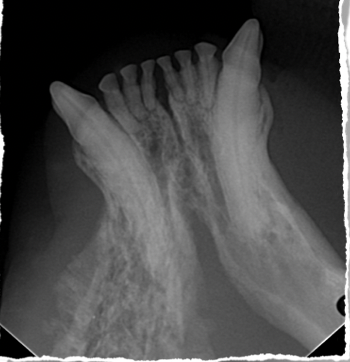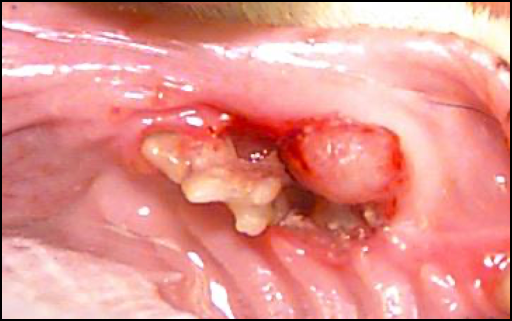
08 Jan Oral Squamous Cell Carcinoma in Cats
Oral Neoplasia (cancer) accounts for 10% of all tumors in cats. Approximately 90% of oral tumors in the cat are malignant. If you discover an oral mass in your kitty’s mouth, you should always bring her in for an evaluation due to their high rate of malignancy. Malignant tumors, such as oral squamous cell carcinoma in cats, are aggressive, grow quickly, and may metastasize (spread) to other parts of the body.
Signs of Oral Cancer in Cats
Clinical signs of oral cancer include facial swelling, oral bleeding, mobile teeth, decreased grooming, decreased appetite, drooling, weight loss, and oral pain. However, it is important to remember that all of these clinical signs can occur with severe periodontal disease and routine oral care is vital to ensure the mouth remains healthy.
Diagnosing Squamous Cell Carcinoma in Cats
Squamous cell carcinoma (SCC) is the most common oral tumor seen in cats and the second most common malignant oral tumor seen in dogs. SCC accounts for 60-70% of feline oral malignant tumors., Cats of all ages may be affected, but the risk increases with age. It often presents as a pink or red, ulcerated mass that bleeds easily.
Squamous cell carcinoma is commonly mistaken for periodontal disease in many feline cases. It is locally invasive and tends to invade bone rapidly. Diagnosis is achieved through a combination of an anesthetized oral exam, dental imaging, and biopsy. Advanced dental imaging such as cone-beam CT or conventional CT is strongly encouraged and warranted for appropriate surgical planning.
Animal Dental Care and Oral Surgery is proud to be the only veterinary facility in Colorado with cone beam computed tomography scanning capability.
Additionally, it is recommended that biopsy samples are submitted to a histopathologist that specializes in oral diseases. Animal Dental Care and Oral Surgery in Colorado Springs, Castle Rock and Loveland utilizes Specialty Oral Pathology for Animals (SOPA) for all our biopsy sample analyses.
nvades the nearby bone. A common location is under the tongue, making identification and treatment challenging. Although metastasis and lymph node involvement is not common in feline oral squamous cell carcinoma, it generally carries a poor prognosis in cats due to the primary tumor’s locally aggressive biologic behavior. Local disease progression interferes with food and water consumption and reduces the pet’s quality of life. Many cats hide illness well, and the discovery of a tumor is often not realized until it has reached an advanced stage.



Figure 1. VetCAT Cone Beam CT Unit
Risk Factors for Developing SSC
In a recent study, it was determined that the development of SSC in cats is multifactorial.
- Tobacco smoke exposure. Exposure to tobacco smoke can lead to a two-fold increase in risk.
- Flea collars. Cats that wear flea collars were 5.3 times more likely to develop oral SCC than cats that did not wear flea collars in one study.
- Canned food. Cats who frequently consumed canned food were 3.6 times more likely to develop oral squamous cell carcinoma than cats that consumed predominantly dry food.
- Canned tuna. Cats that ate canned tuna had a 4.7-fold increased risk than those who did not eat tuna.
Additional studies are warranted to verify these findings and determine whether other risk factors are present.
Treating Oral Squamous Cell Carcinoma
Treatment of feline oral squamous cell carcinoma is curative only for a small percentage of cases where the tumor is able to be completely removed surgically. Radiation and chemotherapy have not proven to be rewarding as sole treatment options. Improved survival
times are likely when curative-intent surgery is completed in combination with radiation therapy. Unfortunately, many cats succumb to local recurrence causing a poor quality of life. Palliative care with appropriate pain management, nutritional support, and control of secondary infections should be considered if surgical treatment is not feasible.
Cat Oral Surgeon in Colorado
Squamous cell carcinoma in cats is an aggressive cancer with a poor prognosis in many cases. Early diagnosis is of paramount importance in treatment and reducing mortality. Additionally, reducing the risk factors such as decreased exposure to tobacco smoke, avoiding canned tuna and flea collars along with frequent oral exams may minimize risk factors. If your cat is in need of a regular cleaning or oral exam, give us a call at Animal Dental Care and Oral Surgery (with locations in Colorado Springs, Castle Pines and Loveland).
1. Stebbins KE, Morse CC, Goldschmidt MH. Feline oral neoplasia: a ten-year survey. Vet Pathol 1989; 26: 121-128.
2. Bilgic O, Duda L, Sánchez MD, Lewis JR. Feline Oral Squamous Cell Carcinoma: Clinical Manifestations and Literature Review. J Vet Dent. 2015 Spring;32(1):30-40.
3. Bertone ER, Snyder LA, Moore AS. Environmental and lifestyle risk factors for oral squamous cell carcinoma in domestic cats. J Vet Intern Med 2003; 17: 557-562.
Photo by Zeke Tucker on Unsplash (1/2/2020)

